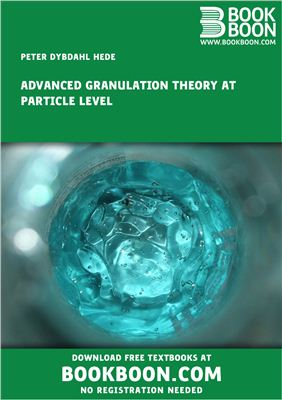1 edition - Ventus Publishing ApS, 2006. - 62 p.
In many types of biochemical and pharmaceutical industries fluid bed granulation in the form of agglomeration and coating processes are essential unit operations in the production of solid products. In order to fully understand the underlying mechanisms behind the numerous phenomena taking place during granulation, it is necessary to study the particle-level phenomena. This is the topic for the present text where relevant models and theory are presented. Thus, you will get an in-depth analysis of the advanced particle-level principles and theory within this important field on a bachelor or master-of-science level.
1. Fluid bed agglomeration at particle level
1.1 Mechanisms involved in the growth rate of granules
1.2 Wetting and nucleation
1.3 Granule growth behaviour and kinetics
1.3.1 Mechanical properties of liquid-bound granules
1.3.1.1 Interparticle forces
1.3.1.2 Static strength - capillary and surface tension forces
1.3.1.3 Dynamic strength - viscous forces
1.3.1.4 Breakage and attrition of wet granules
1.3.1.5 Wet granule strength summary
1.3.2 Granule growth modelling - Class I and Class II models
1.3.2.1 Class I models: Coalescence of non-deformable granules
1.3.2.2 Class I models: Coalescence of deformable granules
1.3.3 Granule growth regimes
In many types of biochemical and pharmaceutical industries fluid bed granulation in the form of agglomeration and coating processes are essential unit operations in the production of solid products. In order to fully understand the underlying mechanisms behind the numerous phenomena taking place during granulation, it is necessary to study the particle-level phenomena. This is the topic for the present text where relevant models and theory are presented. Thus, you will get an in-depth analysis of the advanced particle-level principles and theory within this important field on a bachelor or master-of-science level.
1. Fluid bed agglomeration at particle level
1.1 Mechanisms involved in the growth rate of granules
1.2 Wetting and nucleation
1.3 Granule growth behaviour and kinetics
1.3.1 Mechanical properties of liquid-bound granules
1.3.1.1 Interparticle forces
1.3.1.2 Static strength - capillary and surface tension forces
1.3.1.3 Dynamic strength - viscous forces
1.3.1.4 Breakage and attrition of wet granules
1.3.1.5 Wet granule strength summary
1.3.2 Granule growth modelling - Class I and Class II models
1.3.2.1 Class I models: Coalescence of non-deformable granules
1.3.2.2 Class I models: Coalescence of deformable granules
1.3.3 Granule growth regimes

